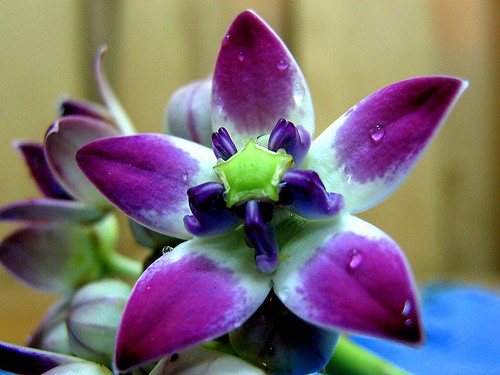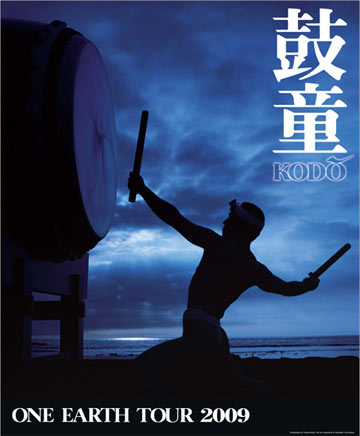2/26/09
Thai costume

Evidence of early Thai costumes can be found in ancient sculptures and literature. The Thai people believed that dressing up in the right color would bring them good luck. This belief can be found in the poems of the Thai poet Soonthornphu, who lived in the Ayutthaya period. His poem entitled Sawatdiruksa, said that the color of clothing should be red on Sunday, white on Monday, violet and dark indigo on Tuesday, bright orange on Wednesday, green and yellow on Thursday, gray like the color of a rain cloud on Friday and black on Saturday. Good idea!)




2/17/09
Milkweed flowers for Shiva

“The gods would not refuse even the trivial erukku for worship,” declared the Purananuru 2000 years ago.Erukku is the Tamil name for Calotropis gigantea, growing now as it must have back then— as “a common wasteland weed” across South Asia. Also known as swallowwort, giant milkweed and (by its flatterers) crown flower, this poisonous plant is sacred to Lord Shiva.

Wherever there are Shiva’s pictures, symbols (the Lingam) or statues, we will see a garland of Calotropis around them. Threaded into strands, the calotropis flowers look like lavender pearls.

OM NAMAH SHIVAYA
2/14/09
Stepwells, part2

Stepwells are most certainly one of India’s most unique, but little-known, contributions to architecture. Stepwells (bawdi or baoli or vav) are in essence wells in which the water can be reached by descending a set of steps.Stepwells were built deep into the earth about 5 to6 storeys in height. These wells were designed to bring people & god and water & life together. These wells meant to entice everyone to leave their abode for a cool drink of water and retreat.These were for dependable, year-round groundwater.
Stepwell Adalaj, Gujarat:




2/13/09
Alla Rakha Khan
Mickey Hart,a published authority on percussion in world music, said
"Allarakha is the Einstein, the Picasso; he is the highest form of rhythmic development on this planet"
Ustad Allah Rakha & his son,Zakir Hussain, Tabla Solo Teental
Kodo

Kodō (鼓童?) is an elite taiko drumming troupe.
In Japanese the word "Kodo" conveys two meanings: "heartbeat" the primal source of all rhythm and, read in a different way, the word can mean "children of the drum," a reflection of Kodo's desire to play their drums simply, with the heart of a child.
Kodo is simply the best at what they do.
2/12/09
Ustad Imrat Khan
Imrat Khan is a consummate musician whose art is based on the deepest insight into the melodic subtleties of rag and the rhythmic intricacies of tal. His breathtaking virtuosity, always used with unerring taste and profound musicality, is placed at the service of a brilliantly inventive wit, which communicates a generous humanity reaching across to audiences of widely different cultures and turns each performance into an unforgettable experience.
Raag Yaman Kalyan on Surbahar:
2/10/09
The Global Drum Project

The GLOBAL DRUM PROJECT Tour brings Mickey Hart, Zakir Hussain, Sikiru Adepoju, and Giovanni Hidalgo together again in a reunion sparked by the 15th anniversary of the ground-breaking album Planet Drum.
"This is a deep drumming groove. We're taking the archaic rhythm worlds into outer space. The Global Drum Project explores rhythm and noise; it's a sound yoga of processed acoustic percussion headed straight for the trance zone that becomes a dance of ancient and modern worlds. Deep drumming is a skeleton key into these realms." -Mickey Hart
Didarganj Yakshi

Regarded as one of the finest example of Indian art, this piece has been exhibited at many museums, the world over.It is estimated to be at least 2000 years old; and is carved out of a single piece of stone. It looks life like, and has exquisite carvings.The slight bend in the left leg endows the statue with a subtle impression of graceful motion, which some observers have described as the "gait of a swan" or maralagimini.

Sarees from Aavaranaa
2/7/09
Spoken Hand
North Indian tabla, Afro Cuban bata, Brazilian samba and West African djembe - it's a Spoken Hand Percussion Orchestra.
The performance left everyone pleasantly overpowered by the collective mastering of such soul-stirring, complex compositions. It was as if I was standing simultaneously on different parts of the world, but everyone was moving to the singular rhythm of the earth.
2/4/09
Gond paintings

The aboriginal tribal paintings of India - The Gond paintings is a freehand expression of the gond tribes of Mandala in Madhya Pradesh (a central Indian state). Painted freehand these two dimensional paintings reflect their perception of life. The third dimension, the depth is always lacking in these paintings reflecting the simplicity of the artist.The origin and starting time of this unique art is unknown but it is quite common to see it on every housewall of the Gondi village.They paint deities, pictures of nature or simply an event of a day to day.Similar to Australian aboriginal paintings.Colorful and descriptive this art has its own charm.

2/2/09
Thaipusam and Kavadi
 Thaipusam is a Hindu festival celebrated mostly by the Tamil community on the full moon in the Tamil month of Thai (8 feb this year). Pusam refers to a star that is at its highest point during the festival. The festival commemorates both the birthday of Lord Murugan (also Subramaniam), the youngest son of Shiva and Parvati, and the occasion when Parvati gave Murugan a vel (lance) so he could vanquish the evil demon Soorapadman.
Thaipusam is a Hindu festival celebrated mostly by the Tamil community on the full moon in the Tamil month of Thai (8 feb this year). Pusam refers to a star that is at its highest point during the festival. The festival commemorates both the birthday of Lord Murugan (also Subramaniam), the youngest son of Shiva and Parvati, and the occasion when Parvati gave Murugan a vel (lance) so he could vanquish the evil demon Soorapadman.
The festival is an intense show of faith. The devotees go on a three-kilometre trek with ritualistic act of worship and thanksgiving. The main participants in trance, haul or carry beautifully decorated kavadis. Kavadi Attam is a dance performed by the devotees during the ceremonial worship. The kavadi itself is a physical burden through which the devotees implore for help from the God Murugan.The festival is an intense show of faith. The devotees go on a three-kilometre trek with ritualistic act of worship and thanksgiving. The main participants in trance, haul or carry beautifully decorated kavadis It is often decorated with flowers, peacock fathers (the vehicle of God Murugan) among other things.
 Generally people take a vow to offer a kavadi to the Lord for purpose of tiding over or averting a great calamity.Though this might on the face of it appear mercenary, a moment's reflection will reveal that it contains in it the seed of love for God. The worldly object is achieved: and the devotee offers the kavadi. After the ceremony is over, he gets so much intoxicated with love of God that his inner spiritual chamber is opened. This too ultimately leads to Para Bhakti - Supreme devotion.
Generally people take a vow to offer a kavadi to the Lord for purpose of tiding over or averting a great calamity.Though this might on the face of it appear mercenary, a moment's reflection will reveal that it contains in it the seed of love for God. The worldly object is achieved: and the devotee offers the kavadi. After the ceremony is over, he gets so much intoxicated with love of God that his inner spiritual chamber is opened. This too ultimately leads to Para Bhakti - Supreme devotion.2/1/09
Rathasapthami

“Ratha” means chariot and “Sapthami” means the 7th day, it is the day when the Sun god is believed to ride on the chariot drawn by 7 horses to gift the beautiful season “Spring” to South India. It is during this time that Sun moves from the southeast to the northeast. 7 represents the colors of the rainbow or the 7 chakras. This festival falls on the 7th day of the Hindu month Maghat, this year it is on 2nd February 2009.
On Rathasapthami day, rangoli/pattern of Sun riding a chariot is drawn. The Temples performs Surya Namaskaram in order to bring good health to the community.

Om Hreem Suryay Namah
Sapthamyam Snana Machareth
KATHAKALI

Like Kerala's KATHAKALI, the mime dance, accompa- nied by music, which is now globally acclaimed as one of the finest art forms. KATHAKALI is a time-tested synthesis of indigenous animistic rituals and theatre traditions evolving into a distinct dance form, with its own unique head- dress, costumes and coloudul makeup. KATHAKALI artists present an exceptional facade with their madeup faces. The makeup takes hours to complete as each character needs a particular colour combination, to depict whether he is a saint or a villain in the play he is to perform.
All these spectacular head dress and mask-like makeup is believed to be an adaptation from THEYYAM make-up techniques. It takes years of hard work to pedect KATHAKALI as it needs total control of the body, and the muscles, including the miniscule movements, to graphically demonstrate every little nuance of emotion... all through facial expressions, especially eye movements and gestures of the hand.

Kathakali mudras or signs have to be mastered to understand their mime. Understanding background music also helps follow the theme. Orchestra on stage has drums, cymbals and a gong. Two singers narrate the story, culled from mythology, like MAHABHARATHA and RAMAYANA.





